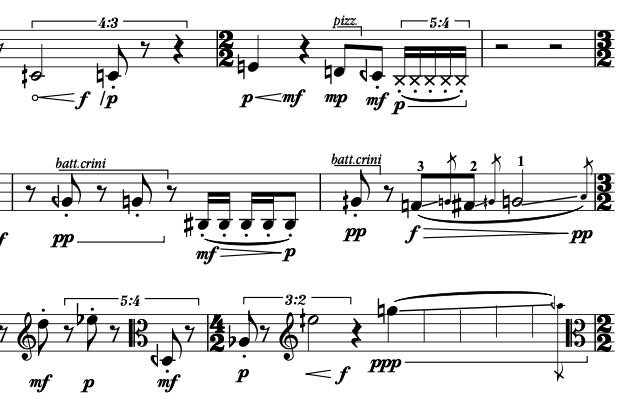Exhaustive permutations of a limited number of parameters controlling additive Supercollider synths. For tuning the voices against each other, a “partial stealing” algorithm is used -- each new sound scans the current harmonic state for partials with which it will form a dissonant relationship, and can then request that these partials be attenuated or muted and their corresponding synths are freed.
A semi-random walk through a collection of samples collected from various ports of the Mutable Instruments Plaits oscillator.
Counterpoint exercise with a repeating chromatic cell. One harmonic and one inharmonic layer with three voices each.
This sketch uses a mix of homebrewed synths (SuperCollider) and sequenced fx chains (Reaper). Each voice consists of bandpassed noise, an additive and a wavetable oscillator. All sounds are created by interpolating 32 synth parameters between four distinct states and layering the results. All frequencies are quantized to a 13-limit just intonation scale.
Excerpt from a slowly unfolding canon with 50 voices for electric guitar and live electronics (Supercollider).
Map (2021) is part of a series of pieces which systematically explores dense, gradually changing instrumental textures.
The music is modelled as a continuous stream of events which modulate a sonority without fundamentally changing its character. Each of the two sections in "Map" consists of 242 events, regularly distributed over a three-minute ritardando. The first section contains five voices; the second contains six.
I am fascinated by the expressive potential of constraint-based systems, where simple rules and patterns interact in complex and often surprising ways. To be able explore a larger variety of systems, I developed a programming environment in Haskell in which I could quickly create and explore different types of harmonic constraints.
While working on the piece, I stumbled across a passage from Ursula Le Guin's utopian science fiction novel "The Dispossessed", in which the fictive composer Salas from the anarchist, resource-constrained planet Anarres describes his own music. It is also a relatively precise description of the music I was searching for:
Five instruments each playing an independent cyclic theme; no melodic causality; the forward process entirely in the relationship of the parts. It makes a lovely harmony.
Written for and performed by Lauren Redhead. Recorded in Evangelische Pfarrkirche, Berlin-Weißensee. Score

For Viola solo. Written for and played by Barbara Maurer (Ensemble Recherche). Score
"Trio" for clarinet, cello, and vibraphone was written in the spring of 2010. The compositional focus is on intonation within the ensemble. The cello has an irregular scordatura, in which natural harmonics produce specific partial tones of different tempered fundamental tones. On their own, these harmonics played on different strings sound unfamiliar and unclear in their mutual relationship. The addition of the tempered reference tones by the other instruments allows these sounds to appear in a different light and integrates them tonally. "Trio" is dedicated to Jonatan Liljedahl. Score